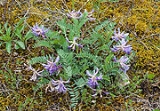
Astragalus bibullatus
Encyclopedia
Astragalus bibullatus (Pyne's ground plum) is an endangered species
of flowering plant
that is endemic
to the cedar glades
of the central basin of Tennessee
. It is found in only three populations located within a few kilometers of each other in Rutherford County, Tennessee
.
The common name refers to Milo Pyne, who discovered the species in the 1980s, and the odd-looking smooth, reddish fruits that ripen on the ground and look superficially like plums. However, the species is a legume and is unrelated to the plum. The foliage of A. bibullatus looks similar to the more widespread cedar glade endemic, A. tennessensis. However, the flowers of A. bibullatus are pinkish purple in contrast to the white flowers of A. tennessensis. The fruits are also quite different. A. tennessensis fruits are greenish, hairy, and are more elongated as is more typical for legumes.
The flowers of A. bibullatus bloom in April and May, while the fruit ripens in May or June.
Endangered species
An endangered species is a population of organisms which is at risk of becoming extinct because it is either few in numbers, or threatened by changing environmental or predation parameters...
of flowering plant
Flowering plant
The flowering plants , also known as Angiospermae or Magnoliophyta, are the most diverse group of land plants. Angiosperms are seed-producing plants like the gymnosperms and can be distinguished from the gymnosperms by a series of synapomorphies...
that is endemic
Endemic (ecology)
Endemism is the ecological state of being unique to a defined geographic location, such as an island, nation or other defined zone, or habitat type; organisms that are indigenous to a place are not endemic to it if they are also found elsewhere. For example, all species of lemur are endemic to the...
to the cedar glades
Cedar glades
A cedar glade is a habitat type unique to the central eastern United States. Cedar glades occur where limestone bedrock occurs near or at the surface. The glade areas proper have very shallow soil or exposed bedrock in some areas. Because of the shallow soil and the extreme conditions created by...
of the central basin of Tennessee
Tennessee
Tennessee is a U.S. state located in the Southeastern United States. It has a population of 6,346,105, making it the nation's 17th-largest state by population, and covers , making it the 36th-largest by total land area...
. It is found in only three populations located within a few kilometers of each other in Rutherford County, Tennessee
Rutherford County, Tennessee
Rutherford County is a county located in the U.S. state of Tennessee. As of the 2010 census, it is the state's fifth-largest county by population with 262,604 people, an increase of 44.3 percent over the 2000 population of 182,023. Its county seat is Murfreesboro, which is also the geographic...
.
The common name refers to Milo Pyne, who discovered the species in the 1980s, and the odd-looking smooth, reddish fruits that ripen on the ground and look superficially like plums. However, the species is a legume and is unrelated to the plum. The foliage of A. bibullatus looks similar to the more widespread cedar glade endemic, A. tennessensis. However, the flowers of A. bibullatus are pinkish purple in contrast to the white flowers of A. tennessensis. The fruits are also quite different. A. tennessensis fruits are greenish, hairy, and are more elongated as is more typical for legumes.
The flowers of A. bibullatus bloom in April and May, while the fruit ripens in May or June.

